The Nghe Tinh Vi-Giam folk singing of Viet Nam is amongst 46 nominations for UNESCO’s recognition as the world intangible cultural heritage of humanity at the UN body’s upcoming session.

During its 9th session on November 24-28, the UNESCO’s Inter-governmental Committee for the Safeguarding of the Intangible Cultural Heritage will examine eight others seeking the status as the cultural heritage in need of urgent safeguarding, Nhan dan newspaper reported, citing sources from an UNESCO press conference in Paris on November 18.
The committee will review national reports on issues, including the current status of heritages inscribed on the List of Intangible Cultural Heritage in Need of Urgent Safeguarding, and the use of international assistance from the Intangible Cultural Heritage Fund and the selection to the Register for Best Safeguarding Practices.
Vi-Giam singing is popular in nearly 260 villages in the central provinces of Nghe An and Ha Tinh.
The two provinces have 51 singing clubs with over 800 vocalists, many of whom are actively preserving the folk music.
Vi-Giam folk music, estimated to have 15 tunes of Vi and 8 airs of Giam, is a repartee sung while working. It reflects the work, cultural lives and feelings of the residents in the central coastal provinces.
Viet Nam now has eight examples of intangible heritage recognised by UNESCO as world intangible heritage, namely Hue's royal court music, Gong space culture in Tay Nguyen (Central Highlands), the northern province of Bac Ninh's love duet singing, the Giong festival, Ca Tru ceremonial singing, Xoan singing, Don Ca Tai Tu music and Hung King’s worship.